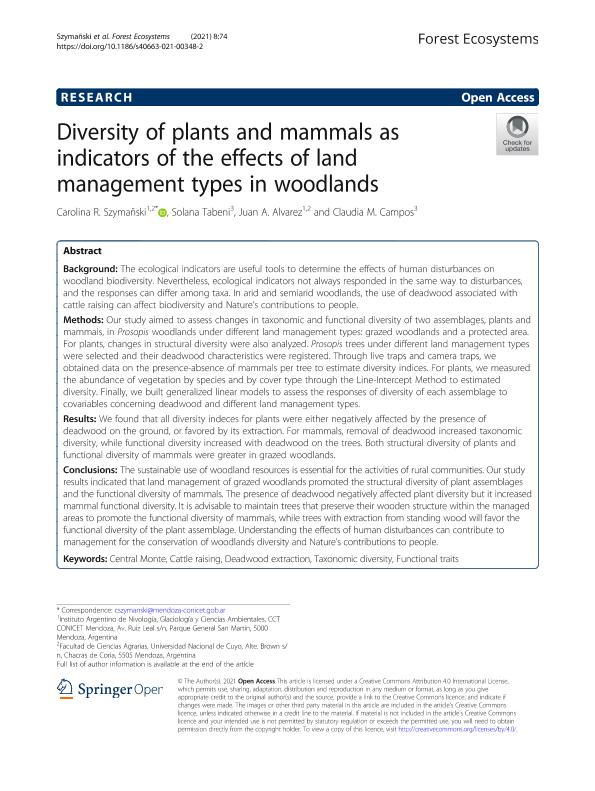Artículo
Diversity of plants and mammals as indicators of the effects of land management types in woodlands
Fecha de publicación:
12/2021
Editorial:
Springer
Revista:
Forest Ecosystems
ISSN:
2095-6355
e-ISSN:
2197-5620
Idioma:
Inglés
Tipo de recurso:
Artículo publicado
Clasificación temática:
Resumen
Background: The ecological indicators are useful tools to determine the effects of human disturbances on woodland biodiversity. Nevertheless, ecological indicators not always responded in the same way to disturbances, and the responses can differ among taxa. In arid and semiarid woodlands, the use of deadwood associated with cattle raising can affect biodiversity and Nature’s contributions to people. Methods: Our study aimed to assess changes in taxonomic and functional diversity of two assemblages, plants and mammals, in Prosopis woodlands under different land management types: grazed woodlands and a protected area. For plants, changes in structural diversity were also analyzed. Prosopis trees under different land management types were selected and their deadwood characteristics were registered. Through live traps and camera traps, we obtained data on the presence-absence of mammals per tree to estimate diversity indices. For plants, we measured the abundance of vegetation by species and by cover type through the Line-Intercept Method to estimated diversity. Finally, we built generalized linear models to assess the responses of diversity of each assemblage to covariables concerning deadwood and different land management types. Results: We found that all diversity indeces for plants were either negatively affected by the presence of deadwood on the ground, or favored by its extraction. For mammals, removal of deadwood increased taxonomic diversity, while functional diversity increased with deadwood on the trees. Both structural diversity of plants and functional diversity of mammals were greater in grazed woodlands. Conclusions: The sustainable use of woodland resources is essential for the activities of rural communities. Our study results indicated that land management of grazed woodlands promoted the structural diversity of plant assemblages and the functional diversity of mammals. The presence of deadwood negatively affected plant diversity but it increased mammal functional diversity. It is advisable to maintain trees that preserve their wooden structure within the managed areas to promote the functional diversity of mammals, while trees with extraction from standing wood will favor the functional diversity of the plant assemblage. Understanding the effects of human disturbances can contribute to management for the conservation of woodlands diversity and Nature’s contributions to people.
Archivos asociados
Licencia
Identificadores
Colecciones
Articulos(IADIZA)
Articulos de INST. ARG DE INVEST. DE LAS ZONAS ARIDAS
Articulos de INST. ARG DE INVEST. DE LAS ZONAS ARIDAS
Articulos(IANIGLA)
Articulos de INST. ARG. DE NIVOLOGIA, GLACIOLOGIA Y CS. AMBIENT
Articulos de INST. ARG. DE NIVOLOGIA, GLACIOLOGIA Y CS. AMBIENT
Citación
Szymañski, Carolina; Tabeni, Maria Solana; Alvarez, Juan Agustin; Campos, Claudia Monica; Diversity of plants and mammals as indicators of the effects of land management types in woodlands; Springer; Forest Ecosystems; 8; 12-2021; 1-15
Compartir
Altmétricas




